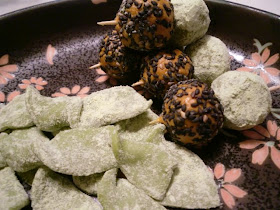
Daifuku is a soft ball of mochi filled with an (sweet bean jam), and ichigo-daifuku is daifuku with a whole fresh strawberry in the center. I can take or leave ordinary daifuku, but ichigo-daifuku is one of my favorite Japanese sweets. The refreshing sweet/sourness of fresh strawberries is a perfect balance to an, and it turns daifuku into a completely different taste experience. Chill it in the refrigerator a while before serving for a delightfully refreshing hot-weather treat. The super simple recipe I've posted below uses mochi made from brown rice, rather than white. White mochi is more traditional, makes a smoother daifuku, and is probably easier to find, so go ahead and use that. I like brown rice mochi because of the higher nutritional value, the coarser texture, and the deeper rice flavor.
Ingredients for four servings:
brown rice (genmai) mochi, four cakes of about 50 grams each
commercially available an, 120 grams (about 1/2 cup)
4 fresh whole strawberries, stems removed
a small amount of cornstarch or katakuriko
You'll also need a microwave oven and a suribachi mortar (but I will suggest a substitute for the mortar later)
Cover the mochi with hot water in a microwave-safe dish for 10 minutes or so. Meanwhile, divide the an into 4 equal portions. When ten minutes has passed, drain the water from the dish of mochi, add two new tablespoons of hot water, and place the dish in microwave. Microwave the mochi (uncovered) for 3~4 minutes at 500W. Place the softened mochi in a suribachi (ribbed mortar) and beat it with a wooden pestle till the mochi is soft and smooth. Place the doughy mochi on wax paper dusted with katakuriko or corn starch. Divide the mochi into 4 equal mounds. Take a mound in your hand and placing it in the palm of your hand, pull and press gently to flatten it into a circle. Place a portion of an in the center of the circle, and place a strawberry on top of the an. Pull the edges of the circle gently up to surround and wrap the filling. Pat into a ball and place on a serving dish.
Variations: Substitute raspberries, blueberries, or any fresh fruit that is sweet/sour and makes a pretty color contrast with the dark an filling.
If you don't have a mortar, you might try putting the softened mochi in a sturdy zip-lock bag and kneading it with the heel of your hand till the mochi turns into a doughy mass.


